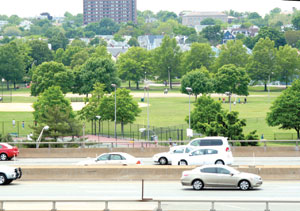
I-93 presents a puzzle for environmental scientists to solve for Somerville. - Photo by Andrew Firestone
UFP research underway for people near I-93
By Andrew Firestone
This week marked a milestone in the Community Assessment of Freeway Exposure and Health (CAFEH) study, as the researchers and scientists involved presented their findings to the public. Four years in to the five-year $2.5 million grant from the National Institute of Health, the project has gone from being merely an idea, to being a comprehensive data-driven study of the effects of Ultra-Fine Particulates (UFP), the dangerous gasses emitted by vehicle exhaust, on human health and its role in causing cardiovascular disease.
In short, the study is attempting to directly link severe health problems and early death with exposure to highway pollution.
Chaired by Somerville’s Ellin Riesner, of community group STEP, and Tufts Dr. Doug Brugge, Professor of Public Health and Community Medicine, the team has, for the last year, been collecting data and surveying residents regarding their experience living within a fourth of a mile of I-93 in East Somerville. Combined with the surveying and clinical tests of residents, the group has also famously been taking data from the air using several monitors throughout the city and a van decked out with scientific gear to view UFP. Now, the work in Somerville is done, and the work in analyzing the millions of data points begins.
“There are elevated levels of ultra-fine particulates near the highway, especially on the down-wind side of the highway, extending out 300 to 400 meters from the highway,” said Brugge of the UFPs, which can reach as high as 100,00 per cubic centimeter, (about the size of a sugar cube). “The exact direction that the plume of ultra-fines are going in and how far it extends and how large it is quite variable,” he said.
These variables, including weather, traffic, time of day and season of the year are what necessitate the long period of scientific analysis, “but I would say that we can confidently say that we’ve seen higher levels of these ultra-fines near the highway as compared to the background area,” said Brugge.
Brugge’s work included the enlistment of Doctoral student Christine Hemphill Fuller of Harvard, who will write her thesis on part of the research on air quality, and Allison St. Vincent, a Tufts PHD student in environmental engineering. St. Vincent was responsible for driving the van.
The study also set up a team who worked to get the surveys and clinical visits completed. The team accomplished the feat of over 200 completed surveys and over 140 clinical tests, which gleaned biometric data from blood samples and tests of residents.
The in-depth nature of the work was necessary to understand the full effects and risks on the average person over a prolonged period. Residents were chosen who were over 40 years of age and after they agreed to perform the hour-long survey. These surveys were carried out by a field team of Somervilliens, including Helene Sroat a 10-year resident. “In general people were friendly and interested,” said Sroat. “In most cases they responded positively and participated in the survey.”
“Some people said that they had felt concerned about it for a long time. That they’d had health concerns in their family and they didn’t know where those had arisen from,” she said.
One such person was longtime Somervillien Joseph Ferrazzani, who had a monitor put in his home, and had twice gone to the clinic to measure chemical levels in his blood and described the field team as “very, very kind” and “very helpful”. “I think it’s very important that people should know about this problem. There are too many homes built near highways, and highways cut through neighborhoods and not enough being done about it,” he said.
Ferrazzani said he had been surprised when he suffered a stroke a few years ago, and while he did not know at the time that chemicals from the highway may have contributed, he said the findings made sense in concordance with health problems he and his loved ones had faced.
“Things get neglected all the time, people get hurt, they don’t know about it, what’s out there in the air,” he said. “I’m not a politician, but I think more people should stand up for it, and tell them not to take our property away and put up a highway.”
Last year, the study was also given an additional $749,893 to study the effects of air filters in mitigating the damages. HEPA air filters were placed in residents’ homes who live near the highway, and their biometric data was monitored as well. The prevalence of minorities living near the highway necessitated the use of Portuguese, Spanish and Haitian Creole to communicate. Luz Padro, a Post-doctoral student at Tufts, assisted in the process.
“I don’t think that CAFEH was framed primarily as an environmental justice study, but I think, de facto, it has that element to it,” said Brugge. “Because the communities that we’re working in: the community of Somerville near the highway, the community of Dorchester in South Boston near the highway, and Boston, Chinatown, are communities that have a large percentage of lower-income people and also a substantial percentage of those are people of color. Environmental justice is really the impact of environmental hazards on low-income and minority communities.”
The study has expanded from Somerville out into Dorchester and Chinatown, which must undergo similar studies before statistical analysis of Somerville pollution can be properly understood. Brugge said he was excited to be at this stage, however, as projects of such ambition and scale usually fail to hit their mark.
“We’ll have this data emerge in a form that we can start working with it and do the analysis that we originally intended for it,” he said. He hoped that his and his team’s work would contribute to public policy when all was said and done.
Between I-93 and Routes 38 and 28, the section of Somerville being studied has around a quarter-million cars that pass through every day on average. Around 30 million Americans live near highways.















Reader Comments